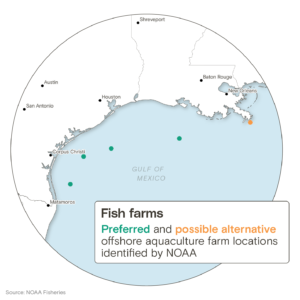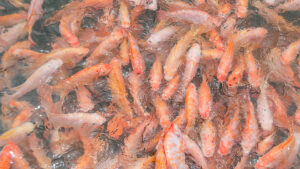This story was originally published by Grist. Sign up for Grist’s weekly newsletter here.
Floating cages with fish by the thousands may be popping in the Gulf of Mexico under a controversial plan that was backed by President-elect Donald Trump’s administration four years ago and is likely to gain traction again after Trump begins his second term next month.
The National Oceanic and Atmospheric Administration, or NOAA, recently identified five areas in the Gulf that the agency says strike a balance between the needs of the growing aquaculture industry and the potential impacts on the marine environment and elements of the seafood industry that depend on wild fisheries.
Identifying these “aquaculture opportunity areas” is part of a decade-long federal plan to open the Gulf and other offshore areas to aquaculture. The plan got a strong push from Trump but slowed under President Joe Biden’s administration, which concludes next month.
Three of NOAA’s preferred aquaculture areas are off the coast of Texas and one is south of Louisiana. Each area ranges from 500 to 2,000 acres and could total 6,500 acres. A fifth area, considered a possible alternative, has been identified near the mouth of the Mississippi River, but it would likely conflict with shipping traffic and shrimping in that area.

The areas would open the Gulf for the first time to the large-scale cultivation of shellfish, finfish and seaweed. Seafood companies have long expressed interest in raising large, high-value species, including redfish and amberjack, in floating net pens several miles off the coasts of Louisiana, Texas and Florida.
Opponents say fish poop, fish feed and other organic debris that often swirls around offshore aquaculture operations will worsen the Gulf’s massive “dead zone,” a New Jersey-size area of low oxygen that pushes away fish and suffocates slow-moving crabs and other shellfish. Fish that escape from floating farms can spread diseases and parasites, gobble up food that supports other species and potentially mate with their wild counterparts, introducing their domesticated genes, which tend to produce slower, dumber fish.
“When you think of all of these environmental impacts, it’s pretty concerning,” said Marianne Cufone, executive director of the New Orleans-based Recirculating Farms Coalition, a group opposed to offshore aquaculture. “Plus, we get super violent storms in the Gulf of Mexico. I don’t know how these [farms] won’t be damaged with fish escaping.”
But the planet’s already-taxed wild fish stocks can’t meet the world’s expanding appetite for seafood alone, said Neil Anthony Sims, CEO of Ocean Era, an aquaculture company that hopes to develop a floating redfish farm 40 miles from Sarasota, Florida. His assertion is backed by a 2021 Stanford University study that predicted global fish consumption is likely to increase by 80 percent over the next 25 years.
“We can’t feed a planet with wild fish anymore than we could feed a planet with wild antelope,” Sims said.
Many fish, including tilapia and catfish, are raised in ponds and other land-based facilities. Floating fish farms in state-managed waters are increasingly rare. In 2022, Washington state effectively banned its once-thriving salmon farming industry after about 260,000 non-native Atlantic salmon escaped from a net pen north of Puget Sound. Hawai‘i still hosts a floating fish farm that raises Hawaiian kampachi, a fish related to amberjack.
Deeper waters managed by the federal government have remained aquaculture-free.
Like Trump, Biden backs opening federal waters to fish farming, but his administration has taken a more methodical approach, directing NOAA to study various areas that may be “environmentally, socially, and economically viable” for supporting offshore aquaculture.
Trump was more forceful during his first term, signing an executive order in 2020 that was aimed at breaking through the regulatory barriers that have long impeded fish farming in federal waters. The Trump administration backed offshore aquaculture as a way to create jobs, broaden markets for U.S. companies, and help meet growing demand for seafood.
A 2020 federal appeals court ruling blocked new regulations allowing offshore fish farming under the Magnuson-Stevens Act, the primary law governing fisheries since 1976. But other laws, including the National Aquaculture Act of 1980 and the Fish and Wildlife Coordination Act of 1980, give NOAA the authority to develop aquaculture opportunity areas and conduct environmental impact permitting for offshore farms.
The opportunity areas unveiled by NOAA last month set the stage for a final green light by Trump or Congress. The public can comment on the opportunity areas until February 20. NOAA will host the first of three virtual meetings to gather feedback on the areas on December 17.
NOAA is also considering aquaculture opportunity areas in Southern California, but opposition is likely to be stiffer there than in the Gulf, where residents are already accustomed to heavily industrialized coastal waters, with thousands of offshore oil and gas structures near Louisiana and Texas and pipelines crisscrossing the seafloor.
But adding more industrial infrastructure will further crowd the Gulf’s first industry: fishing.

“We’re already dealing with the rigs and oil wells and all kinds of debris,” said Acy Cooper, president of the Louisiana Shrimp Association. “And you want to put more out there? It’ll be our downfall.”
The Gulf’s shrimping industry has been losing ground to imported shrimp, which is typically raised in farms in Asia and South America and is far cheaper than the wild-caught varieties.
Cooper, a third-generation shrimper in Plaquemines Parish, said America’s desire for seafood should be met by fishers rather than farmers.
“If you want fish, there’s a lot of fishermen here for you. We’re ready,” he said.
But NOAA isn’t so sure the U.S.’s wild fisheries can support the demand for seafood alone. About 80 percent of the seafood consumed in the U.S. is imported, and about half of the imports are produced via foreign aquaculture. That’s giving rise to a “seafood trade deficit” that had grown to $17 billion in 2020, according to NOAA.
As much as U.S. fishers may want to meet demand, wild stocks are under increasing threat by climate change, which is altering marine species reproduction, feeding habits and distribution.
Offshore fish farming can help the U.S. adapt by producing seafood in a more controlled environment, according to NOAA.
“Aquaculture offers a pathway to grow climate resilience,” said Janet Coit, NOAA Fisheries’ assistant administrator. “Identifying areas suitable for sustainable aquaculture is a forward-looking step toward climate-smart food systems.”
But fish farms will likely worsen the dead zone, one of the Gulf’s main climate-related problems. The dead zone is fueled by agricultural runoff and other nutrient pollution that flushes into the Gulf from the Mississippi River. Rising temperatures speed the growth of algae that feeds on the nutrients. When the massive algal blooms die, their decomposition robs the Gulf of oxygen.
Developing floating farms in and around the dead zone will add even more nutrients from poop and fish food that will nourish bigger blooms, Cufone said.
“We have warmer waters and all of the difficulties our fisheries are having because of climate change, but none of that supports an argument for factory fish farms,” she said. “If we care about climate change, we shouldn’t have them in our oceans.”
This article originally appeared in Grist at https://grist.org/food-and-agriculture/how-trump-could-bring-fish-farms-to-the-gulf-of-mexico/. Grist is a nonprofit, independent media organization dedicated to telling stories of climate solutions and a just future. Learn more at Grist.org.
Sign up for The Invading Sea newsletter by visiting here. To support The Invading Sea, click here to make a donation. If you are interested in submitting an opinion piece to The Invading Sea, email Editor Nathan Crabbe at ncrabbe@fau.edu.



